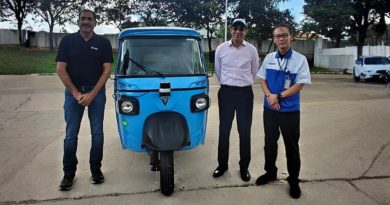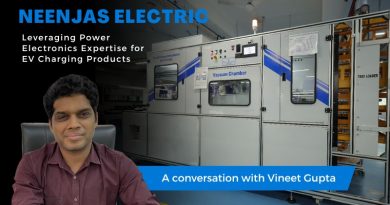Amara Raja Batteries’ plans for lithium-ion cell manufacturing

Amara Raja Batteries has been among the strongest lead-acid battery players in the country. The group is looking beyond and building capabilities as a larger ‘Energy & Mobility’ enterprise. They recently held the groundbreaking ceremony for their lithium-ion giga factory in Divitipalli, Mahabubnagar, Telangana.
In this chat with Vikramadithya Gourineni, Executive Director – New Energy Business, we discover more about this initiative and their overall vision for the energy ecosystem.
Please tell us about your plans for cell manufacturing and the giga corridor Amara Raja is working on.

We recently broke ground for our Li-ion gigafactory. It is the first time we are moving outside of our traditional comfort zone of manufacturing in Andhra Pradesh. We plan to initiate commercial pilot operations (60-100 MWh) within 18-24 months and start sending out B samples / C samples to potential customers. We aim to commence a 2GWh line for NMC cells six months after that.
We already have pack manufacturing in Tirupathi, which will continue as well. In the short term, the battery will remain the heart of any system and intelligence solutions we provide. In addition, we are building capabilities in BMS, analytics and other parts of the ecosystem that will help increase our share of the customer wallet.
What is the planned amount of investment for the project?
The total planned outlay for the project is INR 9500 crores (16GWh cell capacity and 5GWh battery pack capacity). Some of the best plants in the world are deploying at USD 60 million to 70 million per GWh, and we would love to be as close to USD 60M/GWh as possible, though it will take us some time to get there. For the first phase of manufacturing, which includes the 2GWh cell line, battery pack manufacturing, and an R&D centre, we have marked INR 1500-1600 crores.
Which battery chemistries and cell form factors are you planning to manufacture?
We will target the local light mobility market in the early stages. Looking immediately at the electric two-wheeler application, we want to start with NMC. Looking forward, we also see a larger play for LFP chemistry in India.
In terms of form factors, we are planning to start with cylindrical 2170 cells and then increase the size over time. In our larger vision through the end of the decade, we’d be looking at both cylindrical and prismatic form factors.
What is your readiness with respect to technology access for cell manufacturing?
Amara Raja Group’s strength lies in setting up world-class supply chains and manufacturing systems with extremely high precision and quality. We collaborate with different players on a variety of aspects. This first phase of cell manufacturing would be predominantly driven by our own inhouse activities. We have made a series of investments in other promising players; Log9 Materials is one such example. As we scale up manufacturing, we have the option to commercialise specific developments of the companies we are working with or investing in.
Log9 Materials recently announced starting their line for LTO and LFP Cells. What kind of synergies could emerge from there?
We have a great working relationship with Log9. With LTO, they have taken a bet against most of the market. They found a good use case with the last-mile delivery, and I think they’ve been pretty successful rolling it out so far. However, we are not considering LTO. But on the LFP chemistry, especially on a larger cylindrical format that they’re working on, we continue to watch the developments keenly and remain open to supporting and commercialising that technology.
You also invested in a Slovakia-based company called InoBat. What is that partnership about, and how will it help you?
We made a financial investment in InoBat just over 12 months ago. One of our co-investors was also one of the larger material suppliers in the world, Rio Tinto. So, there was some potential synergy with respect to access to raw material. I don’t think that everything panned out quite the way that we would have hoped. But, we continue to remain invested for the time being.
Amara Raja did not make it as one of the winners of the PLI scheme for ACC manufacturing. How did it impact your plans at the time?
With ACC PLI, the Government’s intent is well-understood and well-appreciated, but there were a few areas where we were not able to bid as aggressively. If you look at the requirements for cycle life and density to get worthwhile incentives, I don’t think that many of those specs are available widely in any commercial capacity around the world. I understand the government’s intent was to ensure that the industry does not flood the market with low-performing cells. But those specifications, especially in an infant industry, are going to be quite difficult to pull off at the cost we
are trying to achieve.
Secondly, there was a pretty big driver on the domestic value edition. Now, even at the most aggressive mapping, when we get started in about 24 months from now, we don’t see a great scope to have reliable domestic value addition beyond 25-30%. Anything higher will be forced, and it will come at a significantly higher cost. If you consider the penalties for failing to meet the necessary domestic value addition requirements, they can be quite substantial as well.
But as you can see, it is not really affecting us. Amara Raja, along with many other companies, is going ahead in spite of not being part of the PLI. That being said, there is state government support. Telangana is supporting us in many ways. Our plans are not slowed by any means, but of course, any incentive we could have received would have helped.
What is your outlook for the domestic value chain with respect to cell manufacturing? What can be done to support those efforts?
Amara Raja’s 16GWh capacity alone, even by the end of the decade, will not be significant enough to bring in the large players in cathode, anode, electrolyte, etc. I think all of us need to work together to really help build these capabilities in India. The word competition should not really factor
into the Indian ecosystem today as all of us would benefit from having a local value chain.
Right now, we are keenly looking at speciality chemical manufacturers, their existing product portfolio and how they can support the requirements for the electrolyte, binder etc. We have significant skill in aluminium, and those players can also be convinced to put up some smaller capacities to produce casings and foils to make collectors.
I’m concerned about the ecosystem buildup in India. Until we really get to 60-70% domestic value addition, being globally competitive will remain a challenge. The world is very dependent on the Chinese supply chain right now, and I don’t see that changing in the very near future. I think cell manufacturing will come up far in advance of the supply ecosystem in India. That’s not ideal, but that’s the way it’s going to pan out. One place where I see a little bit of a bright spark is Epsilon on the anode side.
Please tell us about Amara Raja’s vision for becoming an Energy & Mobility enterprise.
As I said earlier, we are looking at how we become not too dependent on only selling a battery to the customer but increasing our share of the wallet. In the short term, we have started putting together a lot of capabilities across the group. We have very strong capabilities in EPC, power electronics and large system integration. e.g. We are used to doing containerized solutions for package substations and building extremely large panels that go into electrical substations. Managing large system integration, especially electrical work, is something we are quite comfortable with.
Until now, these kinds of capabilities were not very synergistic with one another. But with electric vehicles and energy storage coming together, all these things are becoming not just synergistic, but those industries are starting to overlap in a very interesting manner. So bringing that in immediately, we are able to offer battery packs integrated with the charger analytics. With all of our battery packs today, we are also trying to opportunistically sell an off-board EV charger.
Going forward, we look at increasing the related products/services we can offer. Power electronics plus the battery is an important combination for now. But as we start to build on a software layer and more capabilities on the customer side, we will introduce solutions not only for the vehicles but also for energy storage. Home energy is a large segment that would be keen on exploring further as well.
This interview was first published in EVreporter Jun 2023 magazine, which can be accessed here.
You may also read: Lithium-ion battery manufacturing in India- current scenario
Subscribe & Stay Informed
Subscribe today for free and stay on top of latest developments in EV domain.







Pingback: Amara Raja Batteries’ plans for lithium-ion cell manufacturing • EVreporter – Renewable Energy India News
sulfur trioxide pyridine complex The Parikh-Doering oxidation process is an oxidation process that transforms the primary alcohol into secondary ones, transforming them into aldehydes as well as ketones in turn.
Pingback: MHI to conduct re-bidding for remaining 20 GWh cell manufacturing under PLI • EVreporter